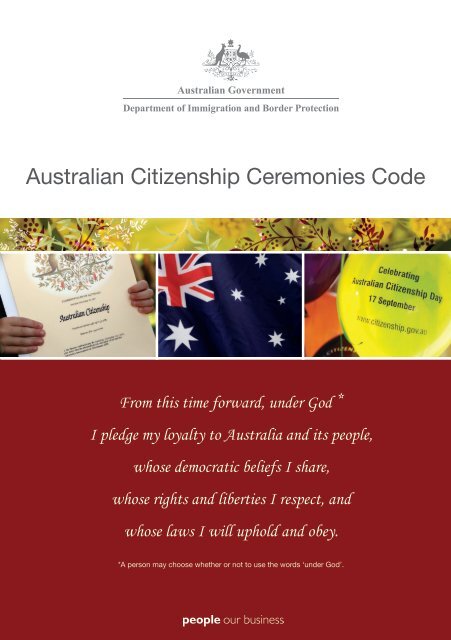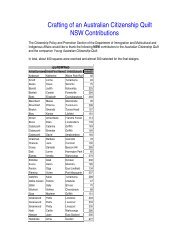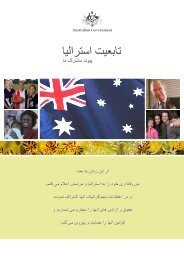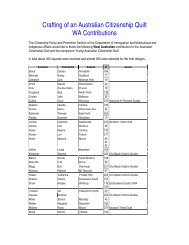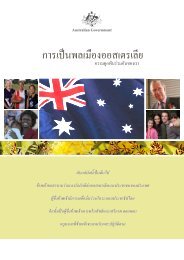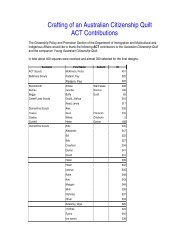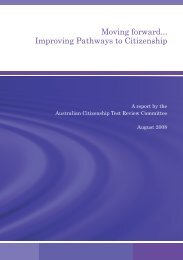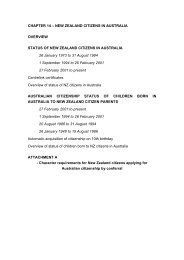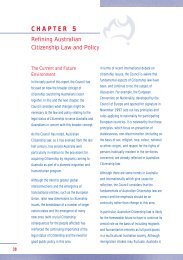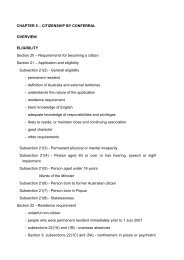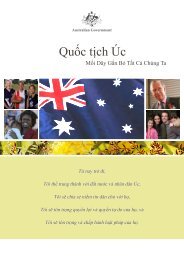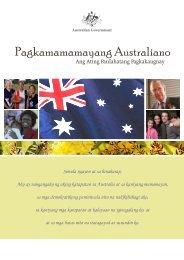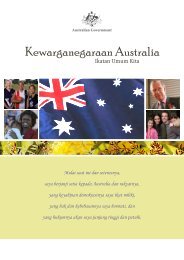Australian Citizenship Ceremonies Code
Australian Citizenship Ceremonies Code
Australian Citizenship Ceremonies Code
Create successful ePaper yourself
Turn your PDF publications into a flip-book with our unique Google optimized e-Paper software.
<strong>Australian</strong> <strong>Citizenship</strong> <strong>Ceremonies</strong> <strong>Code</strong><br />
From this time forward, under God *<br />
I pledge my loyalty to Australia and its people,<br />
whose democratic beliefs I share,<br />
whose rights and liberties I respect, and<br />
whose laws I will uphold and obey.<br />
*A person may choose whether or not to use the words ‘under God’.
<strong>Australian</strong> <strong>Citizenship</strong> <strong>Ceremonies</strong> <strong>Code</strong>
© Commonwealth of Australia 2011 <br />
This work is copyright. You may download, display, print and reproduce this material in unaltered form only <br />
(retaining this notice) for your personal, non-commercial use or use within your organisation. Apart from any <br />
use as permitted under the Copyright Act 1968, all other rights are reserved.<br />
Requests for further authorisation should be directed to the:<br />
Commonwealth Copyright Administration <br />
Copyright Law Branch <br />
Attorney-General’s Department <br />
Robert Garran Offices <br />
National Circuit <br />
Barton ACT 2600<br />
Fax: 02 6250 5989 <br />
Email: commonwealth.copyright@ag.gov.au.<br />
Published by the National Communications Branch of the Department of Immigration and <strong>Citizenship</strong><br />
6 Chan Street Belconnen ACT 2617<br />
ISBN 978-1-921446-67-2<br />
www.citizenship.gov.au<br />
<strong>Australian</strong> <strong>Citizenship</strong> <strong>Ceremonies</strong> <strong>Code</strong><br />
III
<strong>Australian</strong> <strong>Citizenship</strong> <strong>Ceremonies</strong> <strong>Code</strong><br />
Contents<br />
Chapter 1 <strong>Australian</strong> <strong>Citizenship</strong> <strong>Ceremonies</strong> <strong>Code</strong> 1<br />
Chapter 2 <strong>Australian</strong> citizenship 3<br />
Chapter 3 <strong>Citizenship</strong> ceremonies 5<br />
Chapter 4 Types of ceremonies 7<br />
Public ceremonies<br />
Special purpose ceremonies<br />
7<br />
7<br />
Chapter 5 Where to hold a ceremony 9<br />
Chapter 6 When to hold a ceremony 11<br />
Scheduling ceremonies<br />
Parliamentary sitting days<br />
Significant days in the <strong>Australian</strong> citizenship calendar<br />
11<br />
12<br />
12<br />
Chapter 7 Who to invite to a ceremony 15<br />
Candidates<br />
Government representatives<br />
Other official representatives<br />
15<br />
17<br />
18<br />
<strong>Australian</strong> Electoral Commission representatives 18<br />
IV<br />
<strong>Australian</strong> <strong>Citizenship</strong> <strong>Ceremonies</strong> <strong>Code</strong>
Chapter 8 Publicising a ceremony<br />
Obtaining the written consent of candidates for publicity<br />
Chapter 9 Legal requirements for conducting a ceremony<br />
Presiding officer must be authorised by the minister<br />
Presiding officer must read the address<br />
Candidates must make the Pledge<br />
Chapter 10 Important elements of a ceremony<br />
National symbols<br />
Speeches<br />
<strong>Australian</strong> citizenship certificates<br />
<strong>Australian</strong> citizenship affirmation ceremony<br />
Indigenous elements<br />
Chapter 11 Social elements<br />
Entertainment<br />
Gifts<br />
Social gathering<br />
Chapter 12 Tasks to be completed after the ceremony<br />
<strong>Australian</strong> citizenship pledge verification list<br />
19<br />
20<br />
21<br />
21<br />
21<br />
22<br />
25<br />
25<br />
26<br />
27<br />
29<br />
29<br />
31<br />
31<br />
31<br />
32<br />
33<br />
33<br />
Disclosing names and addresses of new citizens to members of parliament 34<br />
<strong>Australian</strong> <strong>Citizenship</strong> <strong>Ceremonies</strong> <strong>Code</strong><br />
V
Chapter 13<br />
Suggested citizenship ceremony program<br />
and order of events 35<br />
Chapter 14 Checklist for conducting a ceremony 37<br />
Chapter 15 <strong>Australian</strong> citizenship affirmation ceremony 41<br />
Appendix 1 Glossary of terms 45<br />
Appendix 2 Address to be read by the presiding officer to<br />
candidates making the Pledge. Schedule 1<br />
of the <strong>Australian</strong> <strong>Citizenship</strong> Regulations 2007 47<br />
Appendix 3 Pledge of Commitment 49<br />
Appendix 4 The <strong>Australian</strong> National Anthem 51<br />
Appendix 5 Opening address—suggested paragraphs 53<br />
Appendix 6 Closing address—suggested paragraphs 57<br />
VI<br />
<strong>Australian</strong> <strong>Citizenship</strong> <strong>Ceremonies</strong> <strong>Code</strong>
<strong>Australian</strong> <strong>Citizenship</strong> <strong>Ceremonies</strong> <strong>Code</strong><br />
Chapter 1<br />
<strong>Australian</strong> <strong>Citizenship</strong> <strong>Ceremonies</strong> <strong>Code</strong><br />
VII
<strong>Australian</strong> <strong>Citizenship</strong> <strong>Ceremonies</strong> <strong>Code</strong><br />
Chapter 1<br />
<strong>Australian</strong> <strong>Citizenship</strong> <strong>Ceremonies</strong> <strong>Code</strong><br />
The <strong>Australian</strong> <strong>Citizenship</strong> <strong>Ceremonies</strong> <strong>Code</strong> provides guidance for organisations<br />
conducting citizenship ceremonies. It sets out the legal and other requirements for<br />
conducting citizenship ceremonies as well as the roles and responsibilities of those<br />
conducting ceremonies.<br />
There are three legal requirements which must be followed.<br />
• The presiding officer must be authorised<br />
by the <strong>Australian</strong> Government minister<br />
responsible for citizenship matters.<br />
• The presiding officer must read<br />
schedule 1 of the <strong>Australian</strong> <strong>Citizenship</strong><br />
Regulations 2007 (preamble for<br />
citizenship ceremonies) to the<br />
candidates. See Appendix 2.<br />
• Most people 16 years of age and over<br />
applying for citizenship by conferral<br />
must make a pledge of commitment<br />
as a citizen of the Commonwealth of<br />
Australia (the pledge). The pledge must<br />
be made before the presiding officer.<br />
These requirements are described in more<br />
detail in Chapter 9.<br />
First new <strong>Australian</strong> citizens following the inaugural<br />
naturalisation ceremony held at Albert Hall in<br />
Canberra on 3 February 1949.<br />
<strong>Australian</strong> <strong>Citizenship</strong> <strong>Ceremonies</strong> <strong>Code</strong> 1
2 <strong>Australian</strong> <strong>Citizenship</strong> <strong>Ceremonies</strong> <strong>Code</strong>
<strong>Australian</strong> <strong>Citizenship</strong> <strong>Ceremonies</strong> <strong>Code</strong><br />
Chapter 2<br />
<strong>Australian</strong> citizenship<br />
<strong>Australian</strong> citizenship is an important common bond for all <strong>Australian</strong>s (whether<br />
<strong>Australian</strong>s by birth or by choice) and lies at the heart of a unified, cohesive and<br />
inclusive Australia.<br />
<strong>Citizenship</strong> celebrates <strong>Australian</strong> democracy, equality under the law and respect<br />
for each others’ beliefs. It is a unique symbol of formal identification with Australia,<br />
acknowledging responsibilities and conferring substantive privileges which allow<br />
people to participate fully in the community.<br />
Responsibilities:<br />
• Obey the laws and fulfill your duties as an <strong>Australian</strong> citizen.<br />
• Enrol on the electoral roll and vote at federal, state, territory and local<br />
government elections and referenda.<br />
• Serve on a jury, if called on.<br />
• Defend Australia, should the need arise.<br />
Privileges:<br />
• The right to vote and elect Australia’s governments.<br />
• The right to apply for appointment to any public office or to nominate for election<br />
as a member of parliament (subject to section 44(i) of the Constitution).<br />
• The right to apply for an <strong>Australian</strong> passport and to leave and re-enter the country<br />
without a visa.<br />
• The right to seek assistance from <strong>Australian</strong> diplomatic representatives while<br />
overseas.<br />
• The right to apply to enlist in the defence forces and to apply for government jobs<br />
requiring <strong>Australian</strong> citizenship.<br />
• The right to register a child born to you overseas after you become an <strong>Australian</strong><br />
citizen, as an <strong>Australian</strong> citizen by descent.<br />
<strong>Australian</strong> <strong>Citizenship</strong> <strong>Ceremonies</strong> <strong>Code</strong><br />
3
4 <strong>Australian</strong> <strong>Citizenship</strong> <strong>Ceremonies</strong> <strong>Code</strong>
<strong>Australian</strong> <strong>Citizenship</strong> <strong>Ceremonies</strong> <strong>Code</strong><br />
Chapter 3<br />
<strong>Citizenship</strong> ceremonies<br />
<strong>Citizenship</strong> ceremonies fulfil legal requirements prescribed by the <strong>Australian</strong> <strong>Citizenship</strong><br />
Act 2007 (the Act) and the <strong>Australian</strong> <strong>Citizenship</strong> Regulations 2007 (the Regulations).<br />
They are conducted under the authority of the <strong>Australian</strong> Government minister responsible<br />
for citizenship matters.<br />
<strong>Citizenship</strong> ceremonies are generally public<br />
ceremonial occasions which provide an<br />
important opportunity to formally welcome<br />
new citizens as full members of the <strong>Australian</strong><br />
community. Representatives of all three levels of<br />
government (federal, state or territory, and local),<br />
community leaders, Aboriginal and Torres Strait<br />
Islander leaders, friends and relatives of the<br />
candidates are invited to attend.<br />
To reflect the significance of the occasion<br />
citizenship ceremonies should be formal and<br />
meaningful occasions conducted with dignity,<br />
respect and due ceremony. They should be<br />
designed to impress upon candidates the<br />
responsibilities and privileges of<br />
<strong>Australian</strong> citizenship.<br />
To maintain the dignity and propriety of the Ceremony at the Brisbane Botanical Gardens 1964<br />
occasion, private commercial activities<br />
(for example sale of souvenirs) should not be<br />
associated with citizenship ceremonies.<br />
<strong>Australian</strong> <strong>Citizenship</strong> <strong>Ceremonies</strong> <strong>Code</strong> 5
<strong>Citizenship</strong> ceremonies are non-commercial, apolitical, bipartisan and secular.<br />
They must not be used as forums for political, partisan or religious expression or for<br />
the distribution of material which could be perceived to be of a commercial, political or<br />
religious nature.<br />
Religious organisations who wish to provide a holy book to new citizens may supply<br />
that book to ceremony organisers to be made available at the venue where the<br />
ceremony is being held. Ceremony organisers should provide the information in a way<br />
that candidates are clearly able to choose whether or not to take one (for example,<br />
provided on a table within the venue). Ceremony organisers should not, however,<br />
imply that a holy book is a requirement for the ceremony.<br />
If you need assistance please contact your nearest office of the Department of<br />
Immigration and <strong>Citizenship</strong> or alternatively visit the citizenship website<br />
www.citizenship.gov.au<br />
6 <strong>Australian</strong> <strong>Citizenship</strong> <strong>Ceremonies</strong> <strong>Code</strong>
<strong>Australian</strong> <strong>Citizenship</strong> <strong>Ceremonies</strong> <strong>Code</strong><br />
Chapter 4<br />
Types of ceremonies<br />
Public ceremonies<br />
Candidates should be encouraged to participate in<br />
a public citizenship ceremony wherever possible.<br />
Local government councils conduct most<br />
citizenship ceremonies.<br />
Community organisations may also conduct<br />
citizenship ceremonies, usually on or near<br />
significant days such as Australia Day, <strong>Australian</strong><br />
<strong>Citizenship</strong> Day and significant national<br />
anniversaries. Community organisations may be<br />
asked to sign an agreement with the department<br />
on how ceremonies are to be conducted.<br />
Special purpose ceremonies<br />
<strong>Australian</strong> <strong>Citizenship</strong> Day 2001 ceremony,<br />
Hobart Town Hall<br />
Special purpose ceremonies may only be arranged when a candidate requires<br />
urgent conferral of <strong>Australian</strong> citizenship or in special circumstances, for example,<br />
where a candidate has a disability preventing their attendance at a public ceremony.<br />
To avoid the appearance of conflict of interest, presiding officers should not confer<br />
<strong>Australian</strong> citizenship on family members, close friends or acquaintances at special<br />
purpose ceremonies.<br />
Invitations to the minister’s representative, members of parliament or community<br />
groups are not necessary for special purpose ceremonies. However if a member of<br />
parliament is invited invitations must be extended to all those required to be invited<br />
to public ceremonies. The attendance of family and friends is normally kept to a<br />
minimum.The <strong>Code</strong> applies to special purpose ceremonies in all other respects.<br />
<strong>Australian</strong> <strong>Citizenship</strong> <strong>Ceremonies</strong> <strong>Code</strong> 7
8 <strong>Australian</strong> <strong>Citizenship</strong> <strong>Ceremonies</strong> <strong>Code</strong>
<strong>Australian</strong> <strong>Citizenship</strong> <strong>Ceremonies</strong> <strong>Code</strong><br />
Chapter 5<br />
Where to hold a ceremony<br />
Local councils and<br />
organisations who conduct<br />
citizenship ceremonies<br />
are encouraged to<br />
consider the formality and<br />
significance of obtaining<br />
<strong>Australian</strong> citizenship when<br />
choosing an appropriate<br />
venue for a citizenship<br />
ceremony.<br />
<strong>Citizenship</strong> ceremonies<br />
may be held out of doors,<br />
for example, in a significant<br />
public space such as a<br />
park or in the same locality<br />
<strong>Citizenship</strong> ceremony at Albert Hall Canberra 2008<br />
as a relevant community<br />
event.<br />
As citizenship ceremonies are apolitical and secular, they should not be held in a<br />
place of worship or in a venue which has political affiliation. However a community<br />
hall adjacent to a place of worship is acceptable.<br />
It is not appropriate for a citizenship ceremony to be held at a venue for the<br />
purpose of promoting a commercial enterprise.<br />
<strong>Australian</strong> <strong>Citizenship</strong> <strong>Ceremonies</strong> <strong>Code</strong> 9
10 <strong>Australian</strong> <strong>Citizenship</strong> <strong>Ceremonies</strong> <strong>Code</strong>
<strong>Australian</strong> <strong>Citizenship</strong> <strong>Ceremonies</strong> <strong>Code</strong><br />
Chapter 6<br />
When to hold a ceremony<br />
Scheduling ceremonies<br />
In keeping with government policy that ceremonies be held at regular intervals,<br />
local government councils should hold ceremonies at least every two to three<br />
months, regardless of the number of candidates available to attend and more<br />
frequently if necessary. There is no maximum or minimum number of candidates<br />
prescribed for citizenship ceremonies.<br />
Local government councils must provide their local office of the department with<br />
a schedule of ceremony dates three to six months in advance. Approximately four<br />
weeks prior to a ceremony, the department will provide councils with a list<br />
of candidates.<br />
Community organisations must give their local office of the department at least<br />
three months notice before the proposed date of the ceremony. This period of time<br />
is needed in order to ensure:<br />
• prospective candidates have sufficient time in which to fulfill application<br />
requirements<br />
• the department has sufficient time in which to process and approve<br />
applications.<br />
Community organisations should also work in partnership with local government<br />
councils to ensure a coordinated approach and the availability of the mayor or<br />
another delegated council officer to act as presiding officer at the community<br />
ceremony. See Chapter 9 for more information on presiding officers.<br />
<strong>Australian</strong> <strong>Citizenship</strong> <strong>Ceremonies</strong> <strong>Code</strong><br />
11
Parliamentary sitting days<br />
It is important and appropriate that elected representatives have the opportunity<br />
to welcome new citizens as formal members of the <strong>Australian</strong> community.<br />
Local Government councils should, therefore, ensure their ceremony schedule<br />
allows for ample opportunity for elected representatives from all three tiers of<br />
government to attend throughout the year.<br />
In order to maximise the likelihood of acceptance of official invitations from elected<br />
representatives of government, wherever possible, citizenship ceremonies should<br />
not be scheduled on federal or state or territory parliamentary sitting days.<br />
One exception is <strong>Australian</strong> <strong>Citizenship</strong> Day, which is celebrated on 17 September<br />
each year. A timetable for federal parliamentary sittings can be obtained from the<br />
<strong>Australian</strong> Parliament House website at www.aph.gov.au/house/info/sittings<br />
Before scheduling citizenship ceremonies organisers should consult with their local<br />
federal member of parliament and a senator from a different political party to that of<br />
the federal member, to ascertain their availability.<br />
Where a citizenship ceremony is scheduled on the same day as a local<br />
government council meeting, the citizenship ceremony should take place prior to<br />
the commencement of the meeting and be conducted with due ceremony and<br />
importance.<br />
Significant days in the <strong>Australian</strong> citizenship calendar<br />
There are two significant days for <strong>Australian</strong> citizenship. These days are:<br />
• Australia Day—26 January<br />
• <strong>Australian</strong> <strong>Citizenship</strong> Day—17 September<br />
Special event days are effective in delivering citizenship messages to the<br />
community. Local governments and community organisations can play an<br />
important role in marking these days for celebration and in raising the awareness<br />
and significance of citizenship in the community.<br />
12 <strong>Australian</strong> <strong>Citizenship</strong> <strong>Ceremonies</strong> <strong>Code</strong>
Australia Day—26 January<br />
Australia Day provides an opportunity for all <strong>Australian</strong>s to reflect and celebrate<br />
their <strong>Australian</strong> citizenship as part of a special day of national celebration and<br />
pride. Australia Day is marked by special events across Australia including special<br />
citizenship and affirmation ceremonies.<br />
<strong>Australian</strong> <strong>Citizenship</strong> Day—17 September<br />
Introduced in 2001, <strong>Australian</strong> <strong>Citizenship</strong> Day is a day for everyone in the<br />
community to reflect on and celebrate the meaning and importance of <strong>Australian</strong><br />
citizenship and the role <strong>Australian</strong> citizens have played in shaping our nation. It is a<br />
day for all <strong>Australian</strong>s to celebrate the values which underpin <strong>Australian</strong> citizenship<br />
including democracy, equality under the law and respect for each others’ beliefs as<br />
well as those aspects of our way of life that unite us.<br />
<strong>Australian</strong> <strong>Citizenship</strong> Day is celebrated with special citizenship ceremonies<br />
affirmation ceremonies and other events around Australia. Local government<br />
councils, community organisations, schools and others in the community are<br />
encouraged to participate in <strong>Australian</strong> <strong>Citizenship</strong> Day.<br />
For ideas on events and activities for celebrating <strong>Australian</strong> <strong>Citizenship</strong> Day visit the<br />
department’s citizenship website at www.citizenship.gov.au<br />
<strong>Australian</strong> <strong>Citizenship</strong> <strong>Ceremonies</strong> <strong>Code</strong><br />
13
14 <strong>Australian</strong> <strong>Citizenship</strong> <strong>Ceremonies</strong> <strong>Code</strong>
<strong>Australian</strong> <strong>Citizenship</strong> <strong>Ceremonies</strong> <strong>Code</strong><br />
Chapter 7<br />
Who to invite to a ceremony<br />
For requirements regarding who to invite to private ceremonies see Chapter 4<br />
Special purpose ceremonies.<br />
Candidates<br />
The department sends each local government council the names of approved<br />
candidates waiting to attend a citizenship ceremony in their local area. Councils<br />
should advise candidates of the date of the ceremony for which they are scheduled<br />
as soon as possible.<br />
Community organisations may identify potential candidates from the local<br />
community or from within the community organisation. Community organisations<br />
should contact their closest departmental office at least three months in advance<br />
of the proposed ceremony date to discuss arrangements.<br />
Inviting candidates<br />
Candidates are invited to attend their ceremony by letter. Depending on local<br />
arrangements, invitation letters are sent to candidates either by the local<br />
government council or by the state or territory office of the department.<br />
For ceremonies conducted by community organisations, the department will<br />
generally send out invitations.<br />
Invitation letters to candidates should include the following advice:<br />
• Date, time and venue for the ceremony and expected arrival time.<br />
• That candidates 16 years of age and over must bring their notification letter<br />
and a form of identification to the ceremony. Identification requirements are<br />
explained below.<br />
<strong>Australian</strong> <strong>Citizenship</strong> <strong>Ceremonies</strong> <strong>Code</strong><br />
15
• That children under 16 years are not required to make a pledge of commitment<br />
or attend a ceremony although they are welcome and encouraged to do so<br />
if they wish. Children under the age of 16 years listed on a ceremony pledge<br />
list as part of a parent’s application only become <strong>Australian</strong> citizens when that<br />
parent becomes an <strong>Australian</strong> citizen. The parent becomes an <strong>Australian</strong> citizen<br />
by making a pledge of commitment at the citizenship ceremony.<br />
• That candidates who wish to make the pledge of commitment on a holy book<br />
or scripture of their choice should bring it to the ceremony.<br />
• That a voluntary affirmation ceremony (if included in the program) will take place<br />
after the citizenship ceremony.<br />
• Any special arrangements concerning seating and the taking of photographs or<br />
video during the ceremony.<br />
• The number of relatives and friends each candidate may invite to attend the<br />
ceremony and subsequent social gathering.<br />
• That candidates may be asked to sign a form giving their consent for<br />
photographs, video or film taken during the ceremony to be used for future<br />
citizenship promotional purposes.<br />
Identifying the candidates<br />
Candidates must be correctly identified on arrival to verify that the people who<br />
will be conferred <strong>Australian</strong> citizenship are in fact the people who were approved<br />
by the department for conferral of <strong>Australian</strong> citizenship. Organisers of citizenship<br />
ceremonies should use their best judgement to satisfy themselves that each<br />
candidate has been correctly identified.<br />
Officers of the department will attend and assist in identifying the candidates for<br />
citizenship ceremonies arranged by community organisations. Name badges for<br />
candidates, official guests and others may be helpful.<br />
Identification requirements for candidates 16 years of age and over<br />
A driver’s licence, passport or other official document which includes a photograph<br />
is preferred.<br />
For candidates who do not have any form of photographic identification, at least<br />
three documents bearing their name, address and signature, for example, bank<br />
statements, credit cards or bills are required.<br />
Candidates should be asked to bring their invitation letter to the ceremony to assist<br />
with identification.<br />
16 <strong>Australian</strong> <strong>Citizenship</strong> <strong>Ceremonies</strong> <strong>Code</strong>
Government representatives<br />
The minister must be invited to all citizenship ceremonies.<br />
When the minister is not able to attend, the minister may nominate a representative.<br />
The minister’s representative may be a government member of the House of<br />
Representatives, a government senator, a senior officer of the department or<br />
another person deemed appropriate by the minister.<br />
When the minister is in attendance the minister will have precedence to assume<br />
the role of presiding officer, conduct the citizenship ceremony and confer <strong>Australian</strong><br />
citizenship on candidates. Any late changes to a ceremony program must be<br />
advised to the department as soon as practicable, so that the minister can be<br />
informed accordingly.<br />
As well as the minister, organisers must also invite:<br />
• the local federal member/s of parliament<br />
• a senator from a different political party to that of the local federal member.<br />
Where an invited senator is not able to attend, another senator from that<br />
political party should be invited.<br />
• the local member/s of the state or territory parliament<br />
• representation from local government when ceremonies are arranged by<br />
community organisations.<br />
The presence of these official guests representing all three levels of government<br />
serves to introduce new citizens to Australia’s three-tiered democratic system of<br />
government as well as to formally welcome them into the <strong>Australian</strong> community.<br />
The focus is on the invitation of elected representatives. Invited elected<br />
representatives cannot send a representative to act in an official capacity on their<br />
behalf.<br />
While a senator or member cannot be prevented from asking an individual to attend<br />
on their behalf, the nominated person should not be included in the official party<br />
and under no circumstances should that person be invited to speak.<br />
The above guidelines also apply during a caretaker period. The emphasis remains<br />
on elected representatives welcoming new citizens to the local community.<br />
Candidates for election may attend the ceremony in a private capacity however<br />
they should not receive an official invitation and should not be included in the official<br />
party. The apolitical nature of the ceremony must be maintained.<br />
<strong>Australian</strong> <strong>Citizenship</strong> <strong>Ceremonies</strong> <strong>Code</strong><br />
17
Other official representatives<br />
Representatives of community and religious organisations and Aboriginal and Torres<br />
Strait Islander leaders may also be invited.<br />
<strong>Australian</strong> Electoral Commission representatives<br />
All organisations conducting citizenship ceremonies should notify the <strong>Australian</strong><br />
Electoral Commission (AEC) of forthcoming citizenship ceremonies to facilitate<br />
electoral enrolment of new citizens. Wherever possible, staff from AEC will attend<br />
ceremonies where ten or more candidates will be present to assist the electoral<br />
enrolment process and to collect completed enrolment forms.<br />
Facilitating electoral enrolment<br />
The department provides pre-printed, personalised electoral enrolment forms<br />
containing the personal details of each candidate to those conducting citizenship<br />
ceremonies.<br />
As enrolment and voting is compulsory for <strong>Australian</strong> citizens, new citizens should<br />
be encouraged to complete their enrolment forms once they have made the pledge<br />
and been presented with their <strong>Australian</strong> citizenship certificate.<br />
Candidates should:<br />
• check that their pre-printed details on the electoral enrolment form are correct<br />
and, if needed, correct any errors<br />
• complete the proof of identity section of the form<br />
• sign the form (in some States this must be witnessed), and<br />
• hand the completed forms to staff from the AEC if present, or post to the AEC<br />
as soon as possible (reply paid 9867 in their capital city).<br />
18 <strong>Australian</strong> <strong>Citizenship</strong> <strong>Ceremonies</strong> <strong>Code</strong>
<strong>Australian</strong> <strong>Citizenship</strong> <strong>Ceremonies</strong> <strong>Code</strong><br />
Chapter 8<br />
Publicising a ceremony<br />
Every effort should be made by organisers to publicise forthcoming ceremonies<br />
and to encourage local and even national media to attend and report on the<br />
event. Publicising citizenship ceremonies promotes to the wider community the<br />
contribution of new citizens to Australia. It also encourages others to acquire<br />
<strong>Australian</strong> citizenship.<br />
Media coverage can be enhanced by providing local media, for example,<br />
newspapers, newsletters and magazines with details of the ceremony as far<br />
in advance as possible. Details provided should include a list of speakers and<br />
important guests. Local community organisations could similarly be informed.<br />
Details of candidates should not be provided to media without their consent.<br />
Where a ceremony could be of interest beyond the local district, consideration<br />
could be given to alerting the national media. Examples of such situations include:<br />
• an unusually large ceremony<br />
• where the ceremony is planned to coincide with a local or national event such<br />
as Australia Day or <strong>Australian</strong> <strong>Citizenship</strong> Day<br />
• where candidates include prominent figures in local affairs, the arts, sport or<br />
other fields, or<br />
• where there are particularly interesting features planned for the ceremony.<br />
When the minister responsible for citizenship is in attendance, liaison with their<br />
media adviser is required for any press releases or media coverage. Public affairs<br />
officers of the department can also assist with publicity arrangements.<br />
<strong>Australian</strong> <strong>Citizenship</strong> <strong>Ceremonies</strong> <strong>Code</strong><br />
19
Obtaining the written consent of candidates for publicity<br />
It is essential that candidates are informed in advance that ceremonies may attract<br />
media attention and that departmental officers or representatives of the media may<br />
attend ceremonies to film, photograph or interview candidates for promotional<br />
purposes. The most opportune time to convey this information is in the invitation<br />
letter.<br />
A departmental consent form is available to obtain the written consent of<br />
candidates as well as their family and friends for their personal information and/<br />
or image to be used for citizenship promotional purposes. Depending on the<br />
circumstances of the ceremony, candidates may be asked to complete the consent<br />
form prior to attending their ceremony, on the day at the time of their registration, or<br />
at the time they are filmed, photographed or interviewed.<br />
While some new citizens may welcome publicity others may not. Local government<br />
councils and community organisations should be aware of privacy obligations. For<br />
more information see the website www.privacy.gov.au<br />
20 <strong>Australian</strong> <strong>Citizenship</strong> <strong>Ceremonies</strong> <strong>Code</strong>
<strong>Australian</strong> <strong>Citizenship</strong> <strong>Ceremonies</strong> <strong>Code</strong><br />
Chapter 9<br />
Legal requirements for conducting a ceremony<br />
There are three legal elements essential in all citizenship ceremonies. A suggested<br />
citizenship ceremony program and order of events indicating how these elements<br />
are incorporated is presented in Chapter 13.<br />
Presiding officer must be authorised by the minister<br />
Under the <strong>Australian</strong> <strong>Citizenship</strong> Act 2007 a person before whom the pledge is made<br />
must be authorised by the <strong>Australian</strong> Government minister responsible for citizenship<br />
matters. These people are usually referred to as presiding officers. Authorisation is<br />
given to <strong>Australian</strong> citizens only and is specific to a position or person.<br />
Presiding officers have no power to appoint a proxy. However, a person may<br />
temporarily perform the duties of the presiding officer when they are:<br />
• acting in place of an authorised person for a period of time, or<br />
• carrying out the bulk of the duties of an authorised position.<br />
A list of people and positions that have been authorised by the minister is available<br />
from state and territory offices of the department. Departmental officers with<br />
authorisation may be available to preside at ceremonies if required.<br />
To avoid the appearance of conflict of interest, presiding officers should not confer<br />
<strong>Australian</strong> citizenship on family members or close friends at private functions.<br />
Presiding officer must read the address<br />
Under Regulation 8 of the <strong>Australian</strong> <strong>Citizenship</strong> Regulations 2007 the presiding<br />
officer must read aloud the address specified in schedule 1 of the Regulations<br />
(preamble for citizenship ceremonies) to the person making the pledge. The<br />
address is at Appendix 2.<br />
<strong>Australian</strong> <strong>Citizenship</strong> <strong>Ceremonies</strong> <strong>Code</strong><br />
21
Candidates must make the pledge<br />
Under the <strong>Australian</strong> <strong>Citizenship</strong> Act 2007, most people 16 years of age and over<br />
applying for citizenship by conferral must make the pledge of commitment as a<br />
citizen of the Commonwealth of Australia before the presiding officer.<br />
The presiding officer should ensure that each candidate makes the pledge by<br />
reciting the pledge out loud. If a candidate fails to make the pledge during a public<br />
citizenship ceremony they should be advised that they are not a citizen and should<br />
again be given the opportunity to make the pledge. Candidates who do not make<br />
the pledge do not become <strong>Australian</strong> citizens and must not be presented with a<br />
certificate.<br />
Pledge cards<br />
Before the ceremony begins each candidate should receive an <strong>Australian</strong><br />
<strong>Citizenship</strong> Pledge card, displaying the words of the pledge of commitment as a<br />
citizen of the Commonwealth of Australia. It may be kept as a memento.<br />
There are two forms of the pledge, clearly marked on the back of the pledge cards.<br />
• Pledge No 1 includes the<br />
words ‘under God’.<br />
• Pledge No 2 does not<br />
include reference to God.<br />
Pledge cards are available<br />
from the state and territory<br />
offices of the department.<br />
(For the two forms of the<br />
pledge see Appendix 2.)<br />
The version of the pledge<br />
which each candidate<br />
has indicated they wish to<br />
make is specified on the<br />
<strong>Australian</strong> citizenship pledge<br />
verification list forwarded to<br />
The Pledge of Commitment must be made by candidates at their<br />
citizenship ceremony.<br />
local government councils by the department. Pledge cards may be placed on the<br />
candidates’ seats or handed to candidates on arrival. Children under 16 years of<br />
age are not required to make the pledge but may do so.<br />
22 <strong>Australian</strong> <strong>Citizenship</strong> <strong>Ceremonies</strong> <strong>Code</strong>
Candidates with disabilities<br />
If a candidate is unable to repeat the pledge because of a substantial impairment<br />
such as a stroke, the pledge may be read to the candidate. The candidate may<br />
then acknowledge by some pre-arranged signal that they understand and agree to<br />
be bound by the words of the pledge.<br />
Holy books and scriptures<br />
It is not a requirement for candidates to use a holy book or scripture or hold up their<br />
hand/s when making the pledge, however, candidates should be permitted to do<br />
so if they wish.<br />
Candidates who wish to use a holy book or scripture when making the pledge, can<br />
bring the holy book or scripture of their choice to the citizenship ceremony.<br />
Note: The General Secretary of the <strong>Australian</strong> Jewish Welfare Society has<br />
requested that members of the Jewish faith be permitted to cover their heads and<br />
open the Bible at the Old Testament when making Pledge No 1.<br />
Administering the pledge<br />
As a matter of practice the presiding officer ‘administers’ (that is reads out and the<br />
candidates repeat) the pledge.<br />
The presiding officer:<br />
• calls on candidates who are to make Pledge No 1 to stand<br />
• asks candidates who wish to make the pledge on a holy book to hold their<br />
book in their hands<br />
• reminds candidates that the words of the pledge are set out on their pledge<br />
card and that they must recite the pledge out loud in order to become<br />
<strong>Australian</strong> citizens<br />
• invites candidates to repeat Pledge No 1 together<br />
• asks candidates to be seated.<br />
The presiding officer then calls on candidates who are to make Pledge No 2 to<br />
stand. The procedure as for Pledge No 1 is repeated.<br />
Alternatively the presiding officer may choose to call first on candidates who wish<br />
to make Pledge No 2.<br />
<strong>Australian</strong> <strong>Citizenship</strong> <strong>Ceremonies</strong> <strong>Code</strong><br />
23
24 <strong>Australian</strong> <strong>Citizenship</strong> <strong>Ceremonies</strong> <strong>Code</strong>
<strong>Australian</strong> <strong>Citizenship</strong> <strong>Ceremonies</strong> <strong>Code</strong><br />
Chapter 10<br />
Important elements of a ceremony<br />
National symbols<br />
In keeping with other Commonwealth official occasions,<br />
the following national symbols must be present in a citizenship ceremony.<br />
These are generally available through the local federal member of parliament<br />
under the Constituents Request Program.<br />
Further guidance on displaying national symbols is available on the It’s an Honour<br />
website at www.itsanhonour.gov.au<br />
Commonwealth Coat of Arms and portrait of the Queen<br />
The Commonwealth Coat of Arms and an official portrait or photograph of<br />
Her Majesty Queen Elizabeth II are to be displayed. The portrait should be placed<br />
behind the presiding officer or in another prominent position at the same level and<br />
to the left (when facing) of the Commonwealth Coat of Arms.<br />
The <strong>Australian</strong> National Flag<br />
The <strong>Australian</strong> National Flag is to be displayed in one of the following ways:<br />
• Flat against a surface, whether horizontally or vertically, with the top left (first)<br />
quarter placed uppermost on the observers’ left as viewed from the front<br />
• On a staff, with the top left quarter placed in the position nearest the top of the<br />
staff. When carried, the flag should be aloft and free, or<br />
• On a flag rope (halyard) with the top left quarter placed uppermost, raised as<br />
close as possible to the top and the flag rope tight.<br />
<strong>Australian</strong> <strong>Citizenship</strong> <strong>Ceremonies</strong> <strong>Code</strong><br />
25
Other <strong>Australian</strong> flags<br />
Aboriginal and Torres Strait Islander flags may be displayed at citizenship<br />
ceremonies.<br />
<strong>Australian</strong> National Anthem<br />
The <strong>Australian</strong> National Anthem (Advance Australia Fair) must be played at the<br />
end of the ceremony. This may be played as a live performance or a recording.<br />
All attendees at the ceremony should be invited to join in singing the National<br />
Anthem. The words of the National Anthem should be provided.<br />
Speeches<br />
Minister’s speech or message<br />
When the minister attends a ceremony, he/she must be invited to speak<br />
immediately after the opening address, before any other official speeches.<br />
When the minister’s representative attends a ceremony, he/she must read the<br />
minister’s message. Organisers will be advised by the minister’s office of the identity<br />
of the minister’s representative before the ceremony. The presiding officer can then<br />
incorporate reference to the minister’s representative in the opening address.<br />
When neither the minister nor his/her representative attend a ceremony, the<br />
minister’s message provided by the department must be read by the presiding<br />
officer. It must be read in its entirety and without amendment immediately after the<br />
opening address, before any other official speeches.<br />
Please ensure you have the latest message from the minister. It can be downloaded<br />
from the citizenship website at www.citizenship.gov.au<br />
Speeches by official guests<br />
Speeches by other official guests must immediately follow the minister’s speech<br />
or the minister’s message (if the minister is not in attendance). All elected local<br />
representatives at the federal, state or territory, and local government level, should<br />
over time have an opportunity to provide a welcoming speech to citizenship<br />
candidates. Not all elected representatives should speak at every ceremony.<br />
This will ensure that the number of speeches is manageable, particularly where<br />
local areas cross a number of electorates.<br />
Other official guests do not have to be invited to speak. However subject to the<br />
number of speeches by elected representatives, a few brief messages of welcome<br />
from local organisations and/or local celebrities will contribute to a feeling of<br />
welcome and fellowship.<br />
26 <strong>Australian</strong> <strong>Citizenship</strong> <strong>Ceremonies</strong> <strong>Code</strong>
Suggested length and content of speeches<br />
To manage the length of the ceremony, each speech should ideally be less than five<br />
minutes long. The presiding officer may wish to draw the following matters to the<br />
attention of those who will be speaking.<br />
• Speeches must be relevant and appropriate to the occasion and must avoid<br />
issues that may be contentious from a political, racial or sectarian point of view.<br />
• Candidates come from a variety of circumstances and backgrounds.<br />
Assumptions and generalisations about their background and their reasons for<br />
coming to Australia should be avoided.<br />
• Speakers may welcome candidates as new citizens and refer to the economic,<br />
social and cultural contribution that new citizens make to Australia. Speakers<br />
could refer, for example, to the development of their local district emphasising<br />
the role of new citizens in industry, civic, cultural affairs or sport. Speakers<br />
could also refer to the many benefits, such as the democratic way of life and<br />
economic opportunities which Australia has to offer its new citizens.<br />
• <strong>Citizenship</strong> ceremonies must not be used as forums for political, partisan or<br />
religious expression or for the distribution of political or religious material.<br />
<strong>Australian</strong> citizenship certificates<br />
It is not a legal requirement that:<br />
• <strong>Australian</strong> citizenship certificates be presented to candidates attending a<br />
ceremony, or<br />
• <strong>Australian</strong> citizenship certificates be presented by the presiding officer or other<br />
authorised person.<br />
However, both of these are common practices.<br />
It is the making of the pledge before an authorised person that is the final legal<br />
requirement for acquiring <strong>Australian</strong> citizenship by conferral.<br />
In most cases, the department will provide <strong>Australian</strong> citizenship certificates to<br />
local government councils in advance of citizenship ceremonies for distribution to<br />
candidates at the ceremony. On the rare occasion that certificates are not available,<br />
the ceremony should continue as scheduled with the certificates forwarded to the<br />
new citizens at a later date.<br />
For community organisations, the departmental officer attending the ceremony will<br />
generally bring the <strong>Australian</strong> citizenship certificates to the ceremony.<br />
<strong>Australian</strong> <strong>Citizenship</strong> <strong>Ceremonies</strong> <strong>Code</strong><br />
27
Safeguarding <strong>Australian</strong> citizenship certificates<br />
<strong>Australian</strong> citizenship certificates are accountable documents and must be subject<br />
to strict security measures at all times. They must be stored in a secure location<br />
such as a safe. Access to them should be restricted to a minimum number of<br />
people.<br />
Presiding officer’s signature<br />
<strong>Australian</strong> citizenship<br />
certificates incorporate a<br />
dotted line at the bottom<br />
front right, where the<br />
presiding officer may sign or<br />
stamp their signature and<br />
include their title of office.<br />
Presenting <strong>Australian</strong><br />
citizenship certificates to<br />
candidates<br />
When family members<br />
are conferred <strong>Australian</strong><br />
citizenship at the same<br />
ceremony, each family<br />
An <strong>Australian</strong> citizenship certificate<br />
member should be presented<br />
with their own certificate.<br />
If children are not part of the ceremony, children’s certificates may be handed<br />
to the parent.<br />
Children under the age of 16 years listed on a ceremony pledge list as part of a<br />
parent’s application only become <strong>Australian</strong> citizens when that parent becomes an<br />
<strong>Australian</strong> citizen. The parent becomes an <strong>Australian</strong> citizen by making the pledge<br />
at the citizenship ceremony.<br />
An issue arises if the children attend the ceremony in the expectation of acquiring<br />
<strong>Australian</strong> citizenship without the parent whose application they are a part of<br />
being present.<br />
Children in this situation do not acquire <strong>Australian</strong> citizenship (even if they make the<br />
pledge or their other parent is present) and should not be provided with <strong>Australian</strong><br />
citizenship certificates. They should be advised to take the matter up with an office<br />
of the department as soon as possible.<br />
28 <strong>Australian</strong> <strong>Citizenship</strong> <strong>Ceremonies</strong> <strong>Code</strong>
Claims that information on <strong>Australian</strong> citizenship certificates is incorrect<br />
If a candidate claims that information on their <strong>Australian</strong> citizenship certificate is<br />
incorrect, they should still be allowed to make the pledge and be presented with<br />
the certificate. They should be advised to take the matter up with an office of the<br />
department as soon as possible.<br />
<strong>Australian</strong> citizenship certificates of candidates who fail to attend a ceremony<br />
Where candidates fail to attend a scheduled ceremony or do not make the pledge,<br />
their certificates must be returned by registered mail, with the signed pledge list<br />
immediately following the ceremony to the office of the department that provided<br />
the certificates.<br />
Altering <strong>Australian</strong> citizenship certificates<br />
Altering <strong>Australian</strong> citizenship certificates is an offence under the <strong>Australian</strong><br />
<strong>Citizenship</strong> Act 2007 and carries serious penalties. Apart from signing the<br />
certificates as indicated above, organisations conducting citizenship ceremonies do<br />
not have legal authority to amend, add or delete any information on the certificates.<br />
<strong>Australian</strong> citizenship affirmation ceremony<br />
To further enhance the meaning and symbolism of citizenship ceremonies,<br />
organisations are encouraged to conduct an <strong>Australian</strong> citizenship affirmation<br />
ceremony at the conclusion of the citizenship ceremony. The affirmation ceremony<br />
must be led by an <strong>Australian</strong> citizen. Information on <strong>Australian</strong> citizenship affirmation<br />
ceremonies is provided in Chapter 15.<br />
Indigenous elements<br />
The department encourages incorporating Indigenous elements into citizenship<br />
ceremonies. This enhances awareness and understanding by new citizens as<br />
well as the wider community of Indigenous culture and heritage and the status of<br />
Indigenous people as the first <strong>Australian</strong>s.<br />
If a local Aboriginal or Torres Strait Islander is not in attendance then the presiding<br />
officer or other appropriate person should publicly acknowledge the traditional<br />
inhabitants of the land where the citizenship ceremony is taking place. An example<br />
of an acknowledgment could be as follows:<br />
‘I recognise the living culture of the xxx people and the unique contribution they<br />
make to the life of the xxx region.’<br />
<strong>Australian</strong> <strong>Citizenship</strong> <strong>Ceremonies</strong> <strong>Code</strong><br />
29
The following are a range of ideas for incorporating Indigenous elements into or<br />
within citizenship ceremonies:<br />
• Invite a local Indigenous leader or leaders to Acknowledge Country and/or<br />
perform a Welcome to Country ceremony.<br />
• Invite members of local Indigenous communities to perform other traditional<br />
Indigenous ceremonies, for example a smoking ceremony, which is generally<br />
used to ‘cleanse’ a site.<br />
• Invite Indigenous artists to perform or a local Indigenous leader or personality to<br />
address the citizenship ceremony.<br />
For further information regarding the significance of Welcome to Country or<br />
Acknowledgement of Country within citizenship ceremonies, contact Reconciliation<br />
Australia via email enquiries@reconciliation.org.au or telephone (02) 6273 9200.<br />
Further information is available at the Reconciliation Australia website<br />
www.reconciliation.org.au<br />
30 <strong>Australian</strong> <strong>Citizenship</strong> <strong>Ceremonies</strong> <strong>Code</strong>
<strong>Australian</strong> <strong>Citizenship</strong> <strong>Ceremonies</strong> <strong>Code</strong><br />
Chapter 11<br />
Social elements<br />
Entertainment<br />
Entertainment befitting the occasion may be incorporated into a ceremony.<br />
Gifts<br />
Local government councils and community organisations conducting citizenship<br />
ceremonies may choose to present gifts to new citizens to mark the acquisition<br />
of <strong>Australian</strong> citizenship. This is entirely voluntary on the part of those conducting<br />
citizenship ceremonies.<br />
Examples of appropriate gifts include:<br />
• an item reflecting Indigenous culture<br />
• a native plant (trees or large shrubs are not appropriate)<br />
• the words of the <strong>Australian</strong> National Anthem<br />
• a free copy of a photograph of the occasion.<br />
<strong>Australian</strong> <strong>Citizenship</strong> <strong>Ceremonies</strong> <strong>Code</strong><br />
31
Social gathering<br />
<strong>Citizenship</strong> ceremonies are generally followed by a social gathering which includes<br />
refreshments. In making these arrangements, organisers should take into account<br />
any special dietary or religious requirements of candidates.<br />
Sing Australia Choir, Australia Day 2008<br />
32 <strong>Australian</strong> <strong>Citizenship</strong> <strong>Ceremonies</strong> <strong>Code</strong>
<strong>Australian</strong> <strong>Citizenship</strong> <strong>Ceremonies</strong> <strong>Code</strong><br />
Chapter 12<br />
Tasks to be completed after the ceremony<br />
<strong>Australian</strong> citizenship pledge verification list<br />
The department provides two copies of the <strong>Australian</strong> citizenship pledge verification<br />
list (pledge list) for each ceremony conducted by councils. This is a listing of<br />
candidates expected to make the pledge at the ceremony and includes some<br />
personal details of candidates designed to assist ceremony organisers to correctly<br />
identify candidates.<br />
Signing and returning the pledge list<br />
It is a legal requirement that each candidate who is making the pledge be formally<br />
registered by the department. To do this, the department relies on organisers<br />
of citizenship ceremonies to return pledge lists promptly. Delays can result in<br />
significant problems being encountered by new citizens, for example, when<br />
applying for an <strong>Australian</strong> passport.<br />
It is essential therefore, that the presiding officer signs the pledge lists immediately<br />
after the conclusion of a ceremony, confirming that each person on the list has<br />
made the pledge. The names of people who failed to attend the ceremony or make<br />
the pledge should be deleted by ruling through their names.<br />
One copy of the completed and signed pledge list must then be forwarded to<br />
the department immediately—together with any unused <strong>Australian</strong> citizenship<br />
certificates.<br />
Pledge lists and certificates should reach the department no later than one<br />
week after the ceremony.<br />
The second signed copy of the pledge list should be given to staff of the AEC<br />
(if attending the ceremony) or forwarded to them by mail. The AEC provides<br />
return envelopes for this purpose.<br />
<strong>Australian</strong> <strong>Citizenship</strong> <strong>Ceremonies</strong> <strong>Code</strong><br />
33
Disclosing names and addresses of new citizens to members<br />
of parliament<br />
The names and addresses of candidates on the pledge list are to be used by<br />
organisations only for the primary purpose of facilitating the conduct of citizenship<br />
ceremonies, for example, to identify the candidates and manage invitations and<br />
RSVPs.<br />
The government views the improper use or disclosure of personal information<br />
provided for the purposes of citizenship ceremonies as completely inappropriate<br />
and has a policy of actively policing such use or disclosure. Inappropriate use<br />
of personal information could lead to withdrawal of authorisation to conduct<br />
citizenship ceremonies.<br />
Whether local federal, state and territory members of parliament attend the<br />
ceremony or not, it is important and appropriate that they have the opportunity to<br />
welcome new citizens as formal members of the <strong>Australian</strong> community.<br />
Local government councils should forward the names and addresses of new<br />
citizens to local federal, state and territory members of parliament where this is<br />
requested. A welcome from a local member of parliament facilitates future contact<br />
between the new citizens and their representatives. This is an authorised secondary<br />
use of candidates’ personal details.<br />
Disclosure of personal information in this way does not contravene state privacy<br />
legislation when councils accompany the information with advice that clearly<br />
states the names and addresses of new citizens are disclosed to local members<br />
of parliament solely for the secondary purpose of welcoming new citizens into the<br />
community.<br />
The advice should also clearly state that the names and addresses of new citizens<br />
should not be forwarded to other persons or organisations, or used by local<br />
members of parliament for any other purpose.<br />
New citizens are informed through application forms for citizenship by conferral that<br />
their information may be disclosed to members of parliament for this purpose.<br />
34 <strong>Australian</strong> <strong>Citizenship</strong> <strong>Ceremonies</strong> <strong>Code</strong>
<strong>Australian</strong> <strong>Citizenship</strong> <strong>Ceremonies</strong> <strong>Code</strong><br />
Chapter 13<br />
Suggested citizenship ceremony program and order<br />
of events<br />
The names of the presiding officer, administrative officer and official guests should<br />
be inserted in the program.<br />
1.30 pm<br />
Candidates arrive and their identity is verified. Candidates should<br />
be briefed on the sequence of the ceremony and the order in which<br />
they will be called to make the pledge.<br />
1.55 pm Official party enters and those present stand.<br />
2.00 pm [Administrative officer] welcomes all present<br />
2.02 pm Welcome to Country or Indigenous acknowledgement<br />
2.05 pm<br />
2.15 pm<br />
2.30 pm<br />
[Presiding officer] welcomes all present; introduces the official<br />
guests; delivers the opening address (suggested wording appears<br />
at Appendix 5); and foreshadows the affirmation ceremony.<br />
[Presiding or administrative officer] introduces each speaker in the<br />
following order:<br />
• Minister or minister’s representative.<br />
• If the minister has not sent a representative, the presiding officer<br />
reads the minister’s message.<br />
• Other speakers.<br />
[Presiding officer] reads the address (preamble for citizenship<br />
ceremonies) to candidates (Appendix 2) making the pledge.<br />
<strong>Australian</strong> <strong>Citizenship</strong> <strong>Ceremonies</strong> <strong>Code</strong> 35
2.32 pm<br />
2.35 pm<br />
2.50 pm<br />
2.53 pm<br />
2.54 pm<br />
2.57 pm<br />
3.00 pm<br />
[Presiding officer] administers the pledge (Appendix 3) to<br />
candidates.<br />
[Presiding officer, administrative officer or official guest] presents<br />
<strong>Australian</strong> citizenship certificates to new citizens and congratulates<br />
them on becoming <strong>Australian</strong> citizens. Each candidate who has<br />
made the pledge is called forward individually to receive their<br />
<strong>Australian</strong> citizenship certificate.<br />
<strong>Australian</strong> citizenship certificates for children may be handed either<br />
to the child’s parent when the parent is presented with their own<br />
certificate or directly to the child.<br />
A gift may also be presented to new citizens.<br />
[Presiding or administrative officer] advises that new citizens may<br />
enrol to vote now by completing the electoral enrolment form given<br />
to them. If staff from the AEC are present, advise that those officers<br />
are available to help.<br />
[Presiding officer] congratulates the new citizens and introduces<br />
the dignitary who will conduct the <strong>Australian</strong> citizenship affirmation<br />
ceremony.<br />
[Presiding officer or other appropriate <strong>Australian</strong> citizen] conducts<br />
the affirmation ceremony. They invite all <strong>Australian</strong>s who wish<br />
to publicly affirm their commitment to Australia and its people,<br />
to stand in their place and join in repeating the affirmation.<br />
Non-citizens should be invited to join at the second line of the<br />
affirmation.<br />
It should be made clear that recitation of the affirmation is voluntary<br />
and that it has no legal effect.<br />
[Presiding officer] asks all present to stand for the <strong>Australian</strong><br />
National Anthem.<br />
[Presiding officer] concludes the ceremony (suggested wording<br />
appears at Appendix 6); and invites new citizens, official guests and<br />
all present to join him/her for light refreshments<br />
36 <strong>Australian</strong> <strong>Citizenship</strong> <strong>Ceremonies</strong> <strong>Code</strong>
<strong>Australian</strong> <strong>Citizenship</strong> <strong>Ceremonies</strong> <strong>Code</strong><br />
Chapter 14<br />
Checklist for conducting a ceremony<br />
Contact the department<br />
• Local government councils must provide the department with a schedule of<br />
ceremony dates three to six months in advance.<br />
• Community organisations must contact the department at least three months<br />
before a planned ceremony date.<br />
Organise the ceremony<br />
• Invite the candidates. If the ceremony is to be hosted by a community<br />
organisation, the department will generally invite the candidates.<br />
• Invite the minister, elected government officials and representatives of local<br />
community groups. Advise officials if they will be invited to make a speech.<br />
• Ensure the presiding officer is authorised by the minister to administer the<br />
pledge.<br />
• Advise the department if the minister or a representative will attend. If neither is<br />
attending, contact the department to obtain the current minister’s message.<br />
• Advise the AEC of the time and date of the ceremony.<br />
• Prepare a ceremony program.<br />
• Ensure the <strong>Australian</strong> citizenship certificates, pledge cards, pledge verification<br />
list, electoral enrolment forms, affirmation cards if required and publicity consent<br />
forms have been received from the department. Departmental officers will bring<br />
these items to ceremonies conducted by community organisations.<br />
• Arrange for the national symbols to be displayed and the National Anthem to be<br />
played.<br />
• Arrange for an Indigenous acknowledgement, a social gathering and an<br />
<strong>Australian</strong> citizenship affirmation ceremony to be incorporated in the ceremony.<br />
<strong>Australian</strong> <strong>Citizenship</strong> <strong>Ceremonies</strong> <strong>Code</strong><br />
37
On the day<br />
• Display the national symbols.<br />
• Identify the candidates correctly against the pledge verification list and their<br />
identity documents. At ceremonies conducted by community organisations,<br />
this will be carried out by departmental officers.<br />
• Obtain the written consent of candidates to publicity if the ceremony is to be<br />
used for promotional purposes.<br />
• Issue pledge cards, electoral enrolment forms (and affirmation cards if required)<br />
to the candidates.<br />
During the ceremony<br />
• The presiding officer must read the minister’s message if the minister or<br />
minister’s representative is not attending.<br />
• Other officials are invited to speak after the delivery of the minister’s speech or<br />
message.<br />
• Presiding officer must read aloud the address specified in schedule 1 of the<br />
Regulations (see Appendix 2) prior to candidates making the pledge.<br />
• Candidates must make the pledge.<br />
• Candidates who have made the pledge are presented with their <strong>Australian</strong><br />
citizenship certificates.<br />
• Arrange for electoral enrolment forms to be completed.<br />
• Conduct an <strong>Australian</strong> citizenship affirmation ceremony if arranged.<br />
• Play the <strong>Australian</strong> National Anthem at the end of the ceremony.<br />
• Invite all to the social gathering if applicable.<br />
38 <strong>Australian</strong> <strong>Citizenship</strong> <strong>Ceremonies</strong> <strong>Code</strong>
Shortly afterwards<br />
• Complete and return both <strong>Australian</strong> citizenship pledge verification lists; one to<br />
the department and the other to the AEC.<br />
• Forward the names and addresses of new citizens to local federal and state/<br />
territory members of parliament, where requested.<br />
• Return all <strong>Australian</strong> citizenship certificates that were not presented at the<br />
ceremony to the office of the department that issued them by registered mail.<br />
Registration desk for new citizens at the Australia Day 2008 citizenship ceremony,<br />
Commonwealth Park, Canberra<br />
<strong>Australian</strong> <strong>Citizenship</strong> <strong>Ceremonies</strong> <strong>Code</strong> 39
40 <strong>Australian</strong> <strong>Citizenship</strong> <strong>Ceremonies</strong> <strong>Code</strong>
<strong>Australian</strong> <strong>Citizenship</strong> <strong>Ceremonies</strong> <strong>Code</strong><br />
Chapter 15<br />
<strong>Australian</strong> citizenship affirmation ceremony<br />
What is the <strong>Australian</strong> citizenship affirmation?<br />
The <strong>Australian</strong> citizenship affirmation is a statement affirming loyalty and<br />
commitment to Australia and its people. It is based on the pledge made by<br />
candidates at citizenship ceremonies in order to become <strong>Australian</strong> citizens.<br />
It reads:<br />
As an <strong>Australian</strong> citizen<br />
I affirm my loyalty to Australia and its people,<br />
whose democratic beliefs I share,<br />
whose rights and liberties I respect,<br />
and whose laws I uphold and obey.<br />
What is an <strong>Australian</strong> citizenship<br />
affirmation ceremony?<br />
The <strong>Australian</strong> <strong>Citizenship</strong><br />
Affirmation<br />
An <strong>Australian</strong> citizenship affirmation ceremony is a short ceremony where all present<br />
are given the opportunity to publicly affirm their loyalty and commitment to Australia<br />
and its people by reciting the <strong>Australian</strong> citizenship affirmation.<br />
Affirmation ceremonies increase awareness of <strong>Australian</strong> citizenship, promote<br />
community involvement and participation, and help people feel that they belong.<br />
They also help build pride in <strong>Australian</strong>s about their citizenship.<br />
<strong>Australian</strong> <strong>Citizenship</strong> <strong>Ceremonies</strong> <strong>Code</strong> 41
Legal status of <strong>Australian</strong> citizenship affirmation ceremonies<br />
Unlike citizenship ceremonies, affirmation ceremonies have no status in law and<br />
no legal effect. No records on participants are required by the department. People<br />
taking part in affirmation ceremonies are not required to prove their <strong>Australian</strong><br />
residence or citizenship status. To avoid confusion with official evidence of<br />
<strong>Australian</strong> citizenship, no certificate should be given to people who participate in an<br />
affirmation ceremony.<br />
Who can host an <strong>Australian</strong> citizenship affirmation ceremony?<br />
<strong>Australian</strong> citizenship affirmation ceremonies may be hosted by community<br />
organisations, schools and local government councils at special events such as<br />
community meetings, functions, festivals and school assemblies. They can also be<br />
part of celebrations for special occasions such as Australia Day (26 January) and<br />
<strong>Australian</strong> <strong>Citizenship</strong> Day (17 September).<br />
Who can participate in an <strong>Australian</strong> citizenship affirmation<br />
ceremony?<br />
Everyone is welcome and participation is voluntary.<br />
Many <strong>Australian</strong>s would not have had an opportunity to declare their commitment<br />
to Australia and its people at a citizenship ceremony because they were born in<br />
Australia.<br />
Some overseas-born <strong>Australian</strong> citizens have previously pledged their commitment<br />
to Australia at a citizenship ceremony. They may however wish to join in and<br />
re-affirm their loyalty to Australia and its people.<br />
There are also many people living in Australia who, although not yet <strong>Australian</strong><br />
citizens, consider Australia their home. They too may wish to express their loyalty to<br />
Australia and show their support for the values that are part of <strong>Australian</strong> citizenship<br />
by joining in the affirmation at the second line.<br />
Who can lead an <strong>Australian</strong> citizenship affirmation ceremony?<br />
An <strong>Australian</strong> citizenship affirmation ceremony must be led by an <strong>Australian</strong> citizen.<br />
They may be a person of some standing in the community or school, for example<br />
an official guest, a leader within the community, a federal or state/territory<br />
parliamentarian or other appropriate person.<br />
42 <strong>Australian</strong> <strong>Citizenship</strong> <strong>Ceremonies</strong> <strong>Code</strong>
For local government councils that incorporate an affirmation ceremony into a<br />
citizenship ceremony, the affirmation ceremony may be led by the presiding officer<br />
who is usually the Mayor or Chief Executive Officer.<br />
As <strong>Australian</strong> citizenship affirmation ceremonies are significant occasions conveying<br />
important symbolism they should be conducted with meaning and dignity.<br />
How to host an <strong>Australian</strong> citizenship affirmation ceremony<br />
An <strong>Australian</strong> citizenship affirmation ceremony should be foreshadowed at the<br />
beginning of the function to allow those present to consider whether they wish to<br />
participate. It should be made clear that participation is voluntary and that reciting<br />
the affirmation has no legal effect.<br />
<strong>Australian</strong> citizenship affirmation cards with the words of the affirmation should be<br />
placed on seats or handed to guests as they arrive. This will allow members of the<br />
audience to become familiar with the words of the affirmation. <strong>Australian</strong> citizenship<br />
affirmation cards are available from state and territory offices of the department or<br />
by visiting the <strong>Australian</strong> citizenship website at www.citizenship.gov.au<br />
The person leading the <strong>Australian</strong> citizenship affirmation ceremony should invite all<br />
who wish to publicly affirm their commitment to Australia and its people, to stand<br />
and join in repeating the affirmation.<br />
Cake to celebrate <strong>Australian</strong> <strong>Citizenship</strong> Day<br />
<strong>Australian</strong> <strong>Citizenship</strong> <strong>Ceremonies</strong> <strong>Code</strong> 43
44 <strong>Australian</strong> <strong>Citizenship</strong> <strong>Ceremonies</strong> <strong>Code</strong>
<strong>Australian</strong> <strong>Citizenship</strong> <strong>Ceremonies</strong> <strong>Code</strong><br />
Appendix 1<br />
Glossary of terms<br />
• Presiding officer: A person who has been authorised in writing by the<br />
<strong>Australian</strong> Government minister responsible for citizenship matters to confer<br />
<strong>Australian</strong> citizenship. In the case of local government councils, this is usually<br />
the Mayor and Chief Executive Officer.<br />
• Administrative officer: A local government official or other person who assists<br />
the presiding officer in arranging and conducting the ceremony.<br />
• Community organisation: An organisation that is not-for-profit, whose<br />
activities are intended to benefit its members and the wider <strong>Australian</strong><br />
community. Examples include Apex, Lions, and Rotary Clubs, Scouts and<br />
Guides Associations and Surf Life Saving Associations.<br />
• The department: <strong>Australian</strong> Government department responsible for<br />
citizenship matters.<br />
• Minister: <strong>Australian</strong> Government minister responsible for citizenship matters.<br />
• Pledge: The pledge of commitment as a citizen of the Commonwealth of<br />
Australia made by candidates under section 26 of the <strong>Australian</strong> <strong>Citizenship</strong> Act<br />
2007 as the last step in becoming <strong>Australian</strong> citizens. There are two forms of<br />
the pledge:<br />
• Pledge 1 using the words ‘under God’<br />
• Pledge 2 without reference to God.<br />
The words are contained on <strong>Australian</strong> <strong>Citizenship</strong> Pledge cards available from<br />
the department. Both pledges are reproduced in Appendix 3.<br />
• <strong>Australian</strong> citizenship certificate: Evidentiary notice given to a person stating<br />
that the person is an <strong>Australian</strong> citizen at a particular time.<br />
<strong>Australian</strong> <strong>Citizenship</strong> <strong>Ceremonies</strong> <strong>Code</strong> 45
46 <strong>Australian</strong> <strong>Citizenship</strong> <strong>Ceremonies</strong> <strong>Code</strong>
<strong>Australian</strong> <strong>Citizenship</strong> <strong>Ceremonies</strong> <strong>Code</strong><br />
Appendix 2<br />
Address to be read by the presiding officer to candidates<br />
making the pledge. Schedule 1 of the <strong>Australian</strong> <strong>Citizenship</strong><br />
Regulations 2007<br />
Preamble for citizenship ceremonies<br />
<strong>Australian</strong> citizenship represents full and formal membership of the community of<br />
the Commonwealth of Australia, and <strong>Australian</strong> citizenship is a common bond,<br />
involving reciprocal rights and obligations, uniting all <strong>Australian</strong>s, while respecting<br />
their diversity.<br />
Persons on whom <strong>Australian</strong> citizenship is conferred enjoy these rights and<br />
undertake to accept these obligations:<br />
(a) by pledging loyalty to Australia and its people; and<br />
(b) by sharing their democratic beliefs; and<br />
(c) by respecting their rights and liberties; and<br />
(d) by upholding and obeying the laws of Australia.<br />
<strong>Australian</strong> <strong>Citizenship</strong> <strong>Ceremonies</strong> <strong>Code</strong> 47
48 <strong>Australian</strong> <strong>Citizenship</strong> <strong>Ceremonies</strong> <strong>Code</strong>
<strong>Australian</strong> <strong>Citizenship</strong> <strong>Ceremonies</strong> <strong>Code</strong><br />
Appendix 3<br />
Pledge of commitment as a citizen of the<br />
Commonwealth of Australia<br />
Form of Pledge No 1<br />
From this time forward, under God,<br />
I pledge my loyalty to Australia and its people,<br />
whose democratic beliefs I share,<br />
whose rights and liberties I respect, and<br />
whose laws I will uphold and obey.<br />
Form of Pledge No 2<br />
From this time forward,<br />
I pledge my loyalty to Australia and its people,<br />
whose democratic beliefs I share,<br />
whose rights and liberties I respect, and<br />
whose laws I will uphold and obey.<br />
<strong>Australian</strong> <strong>Citizenship</strong> <strong>Ceremonies</strong> <strong>Code</strong> 49
50 <strong>Australian</strong> <strong>Citizenship</strong> <strong>Ceremonies</strong> <strong>Code</strong>
<strong>Australian</strong> <strong>Citizenship</strong> <strong>Ceremonies</strong> <strong>Code</strong><br />
Appendix 4<br />
The <strong>Australian</strong> National Anthem<br />
Advance Australia Fair<br />
<strong>Australian</strong>s all let us rejoice,<br />
For we are young and free;<br />
We’ve golden soil and wealth for toil;<br />
Our home is girt by sea;<br />
Our land abounds in nature’s gifts<br />
Of beauty rich and rare;<br />
In history’s page, let every stage<br />
Advance Australia Fair.<br />
In joyful strains then let us sing,<br />
Advance Australia Fair.<br />
Beneath our radiant Southern Cross<br />
We’ll toil with hearts and hands;<br />
To make this Commonwealth of ours<br />
Renowned of all the lands;<br />
For those who’ve come across the seas<br />
We’ve boundless plains to share;<br />
With courage let us all combine<br />
To Advance Australia Fair.<br />
In joyful strains then let us sing,<br />
Advance Australia Fair.<br />
Composed by Peter Dodds McCormick<br />
<strong>Australian</strong> <strong>Citizenship</strong> <strong>Ceremonies</strong> <strong>Code</strong> 51
52 <strong>Australian</strong> <strong>Citizenship</strong> <strong>Ceremonies</strong> <strong>Code</strong>
<strong>Australian</strong> <strong>Citizenship</strong> <strong>Ceremonies</strong> <strong>Code</strong><br />
Appendix 5<br />
Opening address—suggested paragraphs<br />
Below are some suggested paragraphs for the presiding officer’s opening<br />
address. These paragraphs are intended as a guide only and can be drawn on for<br />
incorporation into the speech.<br />
Indigenous acknowledgment<br />
• I would like to acknowledge the traditions of the Aboriginal and Torres Strait<br />
Islander People, (the xxx people), on whose land we are gathered here today.<br />
or<br />
• I recognise the living culture of the xxx people and the unique contribution they<br />
make to the life of the xxx region.<br />
Introduction<br />
• Welcome distinguished guests, ladies and gentlemen.<br />
• This citizenship ceremony is being conducted as prescribed in the <strong>Australian</strong><br />
<strong>Citizenship</strong> Act 2007 and the <strong>Australian</strong> <strong>Citizenship</strong> Regulations 2007 under the<br />
authority of the Minister for Immigration and <strong>Citizenship</strong>.<br />
• I have been authorised as a person who may receive the pledge as a citizen of<br />
the Commonwealth of Australia.<br />
• Making the pledge is the final step in your becoming an <strong>Australian</strong> citizen.<br />
• I am pleased to see so many citizenship candidates here today. I would like to<br />
congratulate each of you on your decision to become an <strong>Australian</strong> citizen—a<br />
decision welcomed not only by me, but by all <strong>Australian</strong>s.<br />
• <strong>Citizenship</strong> is a common bond which unites all <strong>Australian</strong>s, whether they are<br />
Australia’s traditional inhabitants, first generation migrants or the descendants of<br />
earlier settlers. Our rich heritage stems from the contributions made by all of us.<br />
<strong>Australian</strong> <strong>Citizenship</strong> <strong>Ceremonies</strong> <strong>Code</strong> 53
Commitment to Australia and common values<br />
• Acquiring <strong>Australian</strong> citizenship is a public declaration of your commitment to<br />
Australia.<br />
• Acquiring <strong>Australian</strong> citizenship enables those doing so to participate fully in our<br />
inclusive society, realise aspirations and achieve their full potential, regardless of<br />
their race, background, gender, religion, language or place of birth.<br />
• The culture and traditions that migrants bring to Australia, including their<br />
language and religion, contribute in making Australia a vibrant community.<br />
• We have built a nation in which people can bring all that they are to Australia.<br />
We are all free to express and share our cultural heritage within the law, and we<br />
can all participate, contribute and belong as <strong>Australian</strong>s.<br />
• Your <strong>Australian</strong> citizenship is also about making a contribution.<br />
• Australia has a commitment to various values and institutions. These include<br />
parliamentary democracy, equality before the law, freedom of the individual,<br />
freedom of speech and religion, equality between men and women, and<br />
equality of opportunity for all.<br />
• As <strong>Australian</strong>s, you will be members of a community which is democratic and in<br />
which everyone has equal rights and freedom of opportunity.<br />
• Only by accepting our duty as <strong>Australian</strong> citizens can we make sure that our<br />
rights and those of our children will be protected now and in the future.<br />
• You are about to undertake a new commitment, a new responsibility.<br />
• <strong>Australian</strong> citizenship entails responsibilities and privileges.<br />
• <strong>Citizenship</strong> is a public commitment to embracing <strong>Australian</strong> values and<br />
institutions. <strong>Citizenship</strong> brings responsibilities and duties—to obey the laws, to<br />
register on the electoral roll and vote, to serve on a jury if called to do so, and<br />
to defend Australia should the need arise. <strong>Citizenship</strong> also brings civil and social<br />
rights—the right to express your cultural heritage and beliefs coupled with a<br />
responsibility to accept the rights of others to express their heritage and beliefs.<br />
• Our ceremony today recognises that citizenship is a common bond made<br />
meaningful because it embraces an understanding of the rights and<br />
responsibilities of all peoples.<br />
54 <strong>Australian</strong> <strong>Citizenship</strong> <strong>Ceremonies</strong> <strong>Code</strong>
Cultural diversity<br />
• Australia’s strength lies in its people. Our people have made Australia what it is,<br />
building our nation into a vibrant, open and diverse society of which we can all<br />
be proud.<br />
• We hope that those who have not yet applied for <strong>Australian</strong> citizenship will<br />
consider taking the step that those candidates here today have taken and<br />
commit themselves to being a part of Australia’s future.<br />
• We all need to belong to a family or a community, to share a past and to hold<br />
common hopes and goals for the future. By becoming an <strong>Australian</strong> citizen, you<br />
are showing that you want to be a part of Australia’s future.<br />
• No one who applies for <strong>Australian</strong> citizenship is expected to renounce their<br />
cultural identity, customs or traditions.<br />
• Australia’s heritage is made richer by contributions from people from many<br />
lands.<br />
• Today’s Australia has been built from the combined contributions of our<br />
Indigenous people and those who came here later from all over the world. We<br />
accept and respect the cultures and traditions of newcomers and, in return,<br />
expect that they also respect and accept the cultural differences they find here.<br />
While we embrace and celebrate the diversity of the <strong>Australian</strong> people, we also<br />
aim to build a cohesive and unified nation of people. <strong>Australian</strong> citizenship lies at<br />
the heart of a nation founded on all-round equality.<br />
• The aim of all <strong>Australian</strong>s is to build a strong, harmonious and unified nation. To<br />
do this we work together.<br />
• It is important as an <strong>Australian</strong> citizen to understand how our society works and<br />
the democratic principles that guide us. It is also vital to understand how we, as<br />
responsible individuals, can contribute to a better future.<br />
• Australia can take enormous pride in your decision to freely choose to become<br />
part of this nation as a fully participating member. Australia gains by your<br />
commitment to it and through the contribution you will make to its wellbeing.<br />
<strong>Australian</strong> <strong>Citizenship</strong> <strong>Ceremonies</strong> <strong>Code</strong><br />
55
56 <strong>Australian</strong> <strong>Citizenship</strong> <strong>Ceremonies</strong> <strong>Code</strong>
<strong>Australian</strong> <strong>Citizenship</strong> <strong>Ceremonies</strong> <strong>Code</strong><br />
Appendix 6<br />
Closing address—suggested paragraphs<br />
Below are some suggested paragraphs for the presiding officer’s closing address.<br />
These paragraphs are intended as a guide only and can be drawn on for<br />
incorporation into the speech.<br />
• I welcome you as citizens of Australia and I congratulate you on your decision<br />
to become an <strong>Australian</strong> citizen.<br />
• Choosing to become a citizen is a very significant expression of your pride in<br />
being part of Australia’s dynamic and diverse society.<br />
• You have made a pledge of commitment to Australia and its people and have<br />
been provided with a memento card to mark the occasion of the commitment.<br />
• <strong>Australian</strong> citizens value many basic rights including equality of treatment,<br />
equality under the law, democracy and equal opportunity for all.<br />
• Our culturally diverse society is founded on a ‘fair go’ for all <strong>Australian</strong>s.<br />
• Now that you are <strong>Australian</strong> citizens you enjoy specific privileges and<br />
responsibilities, such as the right to vote to help elect Australia’s governments<br />
and access to an <strong>Australian</strong> passport.<br />
• Australia’s future success depends on the way we work together.<br />
• Your <strong>Australian</strong> citizenship is a symbol of your commitment to Australia and your<br />
formal membership of the <strong>Australian</strong> community.<br />
• Australia gives all <strong>Australian</strong>s the opportunity to live and grow in a free and open<br />
society and to share in the common good. In return, we owe Australia our duty<br />
as good neighbours and good citizens.<br />
<strong>Australian</strong> <strong>Citizenship</strong> <strong>Ceremonies</strong> <strong>Code</strong> 57


